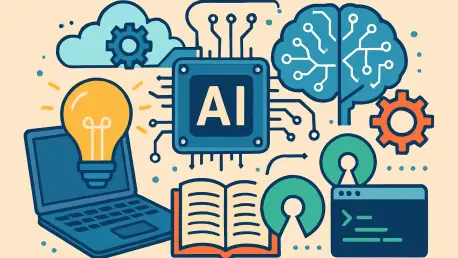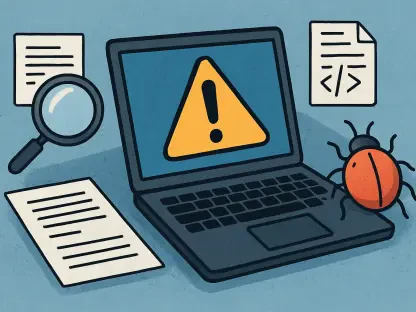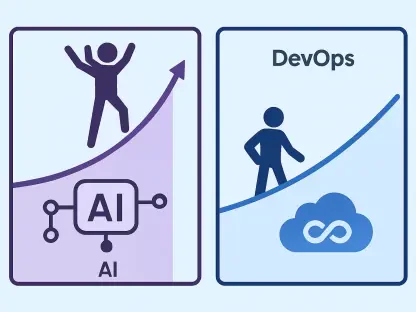In a world where artificial intelligence (AI) is reshaping global power dynamics, Andy Konwinski, co-founder of Databricks, has emerged with a compelling argument that open-source AI could be the United States’ strongest tool to maintain technological supremacy over China. Speaking at the Cerebral Valley AI Summit, Konwinski emphasized that sharing AI research and models publicly is not merely a driver of innovation but a critical component of national security and democratic resilience. His perspective casts openness as a strategic necessity, one that could accelerate U.S. advancements while ensuring transparency in how transformative technologies are developed and deployed. As China ramps up its own AI efforts with aggressive open-source strategies, the stakes for the U.S. to adopt a similar approach have never been higher. This discussion delves into the historical impact of open AI, the geopolitical challenges, and the practical steps needed to secure a competitive edge through collaboration.
Historical Impact of Open Innovation
The transformative power of open-source AI is not a new concept, but rather a proven force that has reshaped the technological landscape over recent years. Konwinski highlighted the 2017 Transformer architecture paper as a pivotal moment, noting how its public availability triggered a global explosion of research that ultimately gave rise to today’s sophisticated generative AI models. By making such foundational work accessible, the barriers to entry for researchers and developers were significantly lowered, fostering an environment where ideas could be tested and refined by a diverse community. This collaborative spirit has been instrumental in driving rapid progress, ensuring that advancements are not confined to a select few but instead benefit a wider array of innovators. The result is a vibrant ecosystem where even small teams can contribute to cutting-edge developments, reinforcing the U.S. position as a leader in AI when such openness is prioritized.
Beyond historical examples, the ongoing impact of open models like Meta’s Llama and Stability AI’s diffusion tools underscores the value of democratized access. These resources have empowered startups, academic institutions, and enterprises to experiment without the prohibitive costs associated with proprietary systems, effectively shortening innovation cycles. Konwinski argues that this accessibility is a cornerstone of maintaining a competitive edge, as it allows for a broader pool of talent to engage with and build upon existing technologies. When contrasted with closed systems that limit participation, open-source AI creates a multiplier effect, where shared knowledge leads to exponential growth in capability and application. Embracing this model strategically could ensure that the U.S. continues to set the pace in AI development, provided the necessary support structures are in place to sustain such efforts.
Geopolitical Urgency in the AI Race
The geopolitical dimension of AI development adds a layer of urgency to Konwinski’s advocacy for open-source strategies, particularly in light of China’s aggressive push in this domain. By releasing models and research publicly, China has created a fertile ground for rapid iteration and improvement among developers, accelerating their technological advancements at an alarming rate. This approach contrasts sharply with the risk of the U.S. falling behind if its most innovative ideas remain trapped within private laboratories. Konwinski warns that such isolation could cede critical ground, especially as data shows China already surpassing the U.S. in the sheer volume of AI publications and patents. The potential for the next game-changing breakthrough to originate outside American borders poses not only an economic threat but also a challenge to shaping global norms around powerful technologies.
Moreover, the implications of losing this race extend beyond mere innovation to the very principles that underpin democratic societies. If China secures dominance in AI through open collaboration while the U.S. remains siloed, the ability to influence how these technologies are governed could slip away. Konwinski stresses that public oversight, enabled by transparency in research, is essential to ensure AI aligns with values of accountability and fairness. Without a robust open-source framework, the U.S. risks not only a technological lag but also diminished influence over ethical standards in AI deployment. The urgency to act is clear: embracing openness is not just about keeping up but about preserving a leadership role in defining the future of global tech governance amid intensifying competition.
Challenges Hindering Open AI Progress
Despite the compelling case for open-source AI, significant obstacles stand in the way of its widespread adoption within the U.S., particularly concerning talent and resource availability. One major issue is the aggressive recruitment of top academic minds by private labs, which offer salaries far beyond what universities can compete with. This talent drain disrupts the traditional pipeline of collaboration and idea-sharing that has long fueled American technological research. As a result, the flow of preprints, open discussions, and shared discoveries that once characterized the academic environment is drying up, leaving smaller institutions and independent researchers at a disadvantage. Konwinski views this as a critical barrier to sustaining an open innovation culture, one that could undermine the U.S. ability to compete on a global scale if left unaddressed.
Another pressing challenge lies in the astronomical costs associated with training advanced AI models, often reaching into the tens or hundreds of millions of dollars. Such financial barriers limit access to high-powered computing resources, effectively excluding many researchers and smaller entities from participating in cutting-edge experimentation. This disparity creates a landscape where only well-funded corporations can push the boundaries of AI, concentrating progress in a few hands rather than distributing it across a diverse community. Konwinski argues that these compute bottlenecks are not just technical hurdles but strategic threats, as they stifle the very experimentation that open-source systems are meant to encourage. Addressing these resource gaps is essential if the U.S. hopes to leverage the full potential of shared AI development to maintain its competitive edge.
Policy Solutions to Drive Open AI
To overcome the barriers facing open-source AI, Konwinski proposes a series of actionable policy interventions designed to level the playing field and foster collaboration. Among his suggestions is federal funding for high-quality datasets that can be freely accessed by researchers, alongside compute credits for academic and nonprofit labs that commit to sharing their code and model weights. Such measures would lower the financial barriers to entry, enabling a wider range of participants to engage in meaningful AI development. Additionally, tying federal grants to transparency requirements—such as documenting training data sources—could ensure that publicly funded research contributes to the broader ecosystem. These steps, if implemented, could reinvigorate the collaborative spirit that has historically driven U.S. tech progress.
Further policy recommendations include prioritizing open models in government procurement processes, provided they adhere to established safety standards, as a way to signal market support for transparency. Konwinski also calls for competition policies to prevent large labs from stifling open alternatives through exclusive data agreements or restrictive licensing. By curbing monopolistic practices, such regulations would encourage a more dynamic environment where innovation is not hoarded but shared for collective benefit. These policy shifts represent a strategic pivot, aiming to align national interests with the principles of openness while addressing the structural challenges that currently hinder progress. If enacted, they could position the U.S. to harness open-source AI as a powerful tool for maintaining technological leadership in an increasingly competitive global landscape.
Addressing Safety in Open AI Systems
The conversation around open-source AI inevitably raises concerns about safety, particularly the potential misuse of open-weight models in harmful ways, a point Konwinski does not overlook. Rather than advocating for restrictive measures that could push research into unregulated or offshore spaces, he champions a model of accountable openness supported by robust governance. Proposals include rigorous stress-testing of models before release, implementing content filters to mitigate harmful outputs, and establishing liability frameworks for negligent deployment. Such mechanisms aim to balance the benefits of widespread access with the need to protect against risks, ensuring that openness does not equate to recklessness in the pursuit of innovation.
Additionally, Konwinski points to existing frameworks like the NIST AI Risk Management guidelines as a foundation for setting alignment benchmarks that prioritize safety without stifling progress. By integrating these standards into the development and release of open models, the U.S. can foster an environment where innovation is both dynamic and responsible. This approach acknowledges that while risks exist, they are better managed through transparent collaboration than through closure, which could drive dangerous experimentation underground. Emphasizing governance over restriction, these strategies seek to maintain public trust in open AI systems while addressing legitimate concerns about their potential downsides, offering a pragmatic path forward.
Economic Benefits of Open AI Ecosystems
The economic advantages of embracing open-source AI are substantial, as Konwinski highlights with concrete examples of market transformation driven by accessible models. Stable Diffusion, for instance, has catalyzed a creative boom in industries like design and marketing, enabling professionals to leverage powerful tools without prohibitive costs. Similarly, Llama models have facilitated thousands of enterprise pilots across sectors such as healthcare and finance, demonstrating how open systems can spawn new applications and revenue streams. These cases illustrate that openness is not just a technical strategy but a catalyst for economic growth, creating opportunities for businesses of all sizes to innovate and compete in a rapidly evolving landscape.
Equally important is the long-term impact on the broader innovation ecosystem, which Konwinski warns could be jeopardized by concentrating breakthroughs within a few private entities. While such concentration might yield short-term profits for select companies, it risks weakening the diverse network of contributors that ultimately drives sustained progress. Open ecosystems, by contrast, ensure that even the largest players benefit from a thriving community of ideas and applications, fostering resilience and adaptability. Supporting open AI is thus a dual investment—in immediate economic gains through new markets and in the enduring strength of a collaborative tech landscape that underpins U.S. competitiveness over time.
Strategic Imperative for Future Leadership
Reflecting on Konwinski’s arguments, it becomes evident that the push for open-source AI is a defining moment in the quest for U.S. technological dominance. The historical successes of shared research have laid a foundation, while the geopolitical rivalry with China has sharpened the urgency to act decisively. Challenges like talent shortages and compute costs have been identified as critical barriers, yet actionable policy solutions have been proposed to bridge those gaps. Safety concerns have been met with calls for governance rather than restriction, and the economic windfalls of open ecosystems have been showcased through real-world impact. Looking ahead, the next steps involve policymakers and industry leaders uniting to fund accessible resources, enforce transparency, and build safety frameworks that sustain trust. Only through such coordinated efforts can the U.S. secure its position as a leader in AI, ensuring that innovation remains both a national strength and a global benchmark for democratic values.









